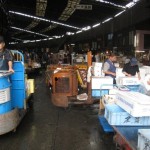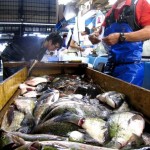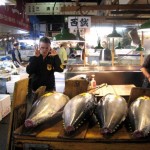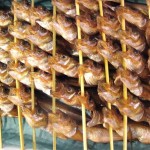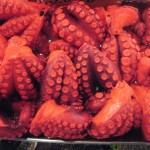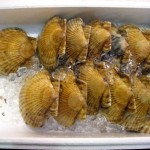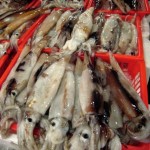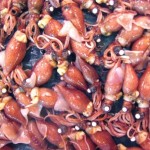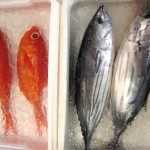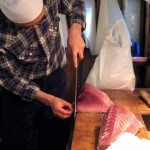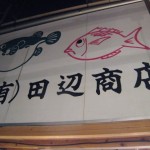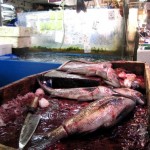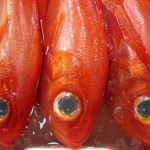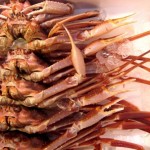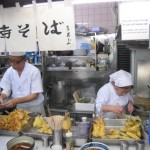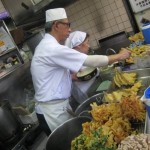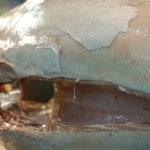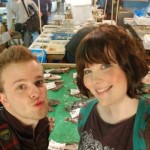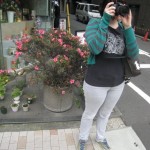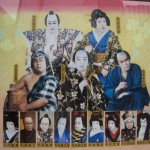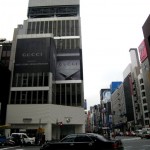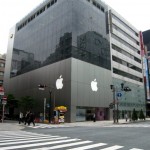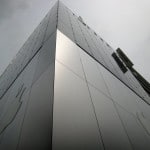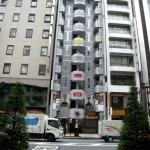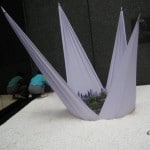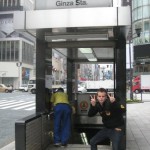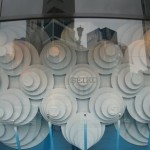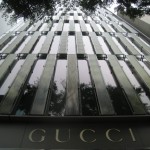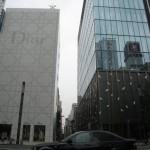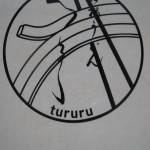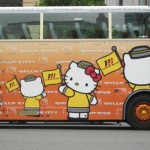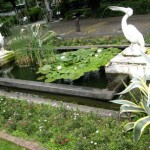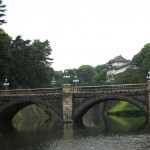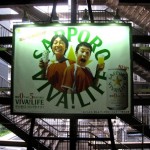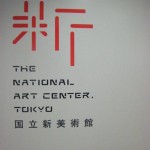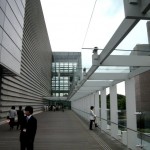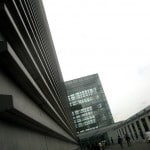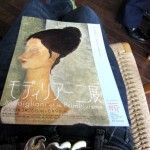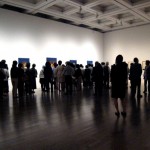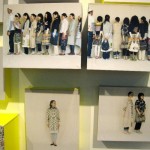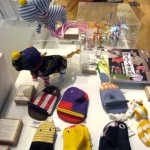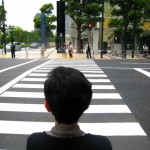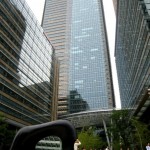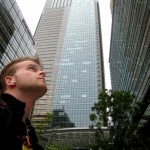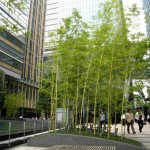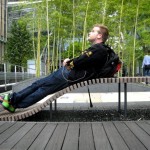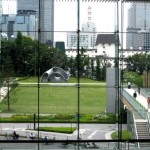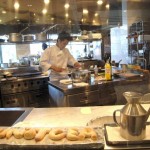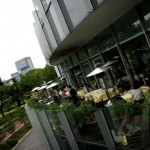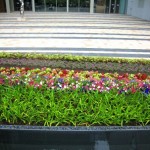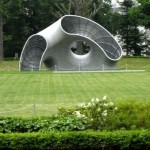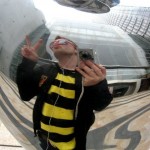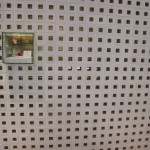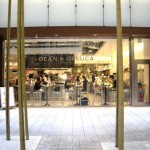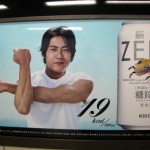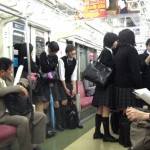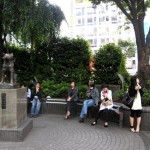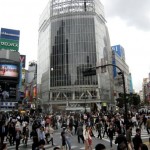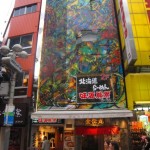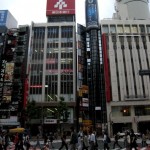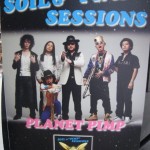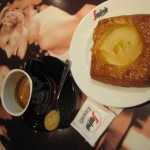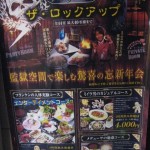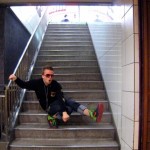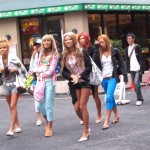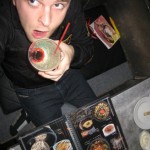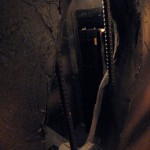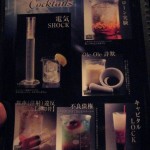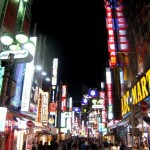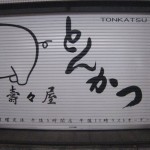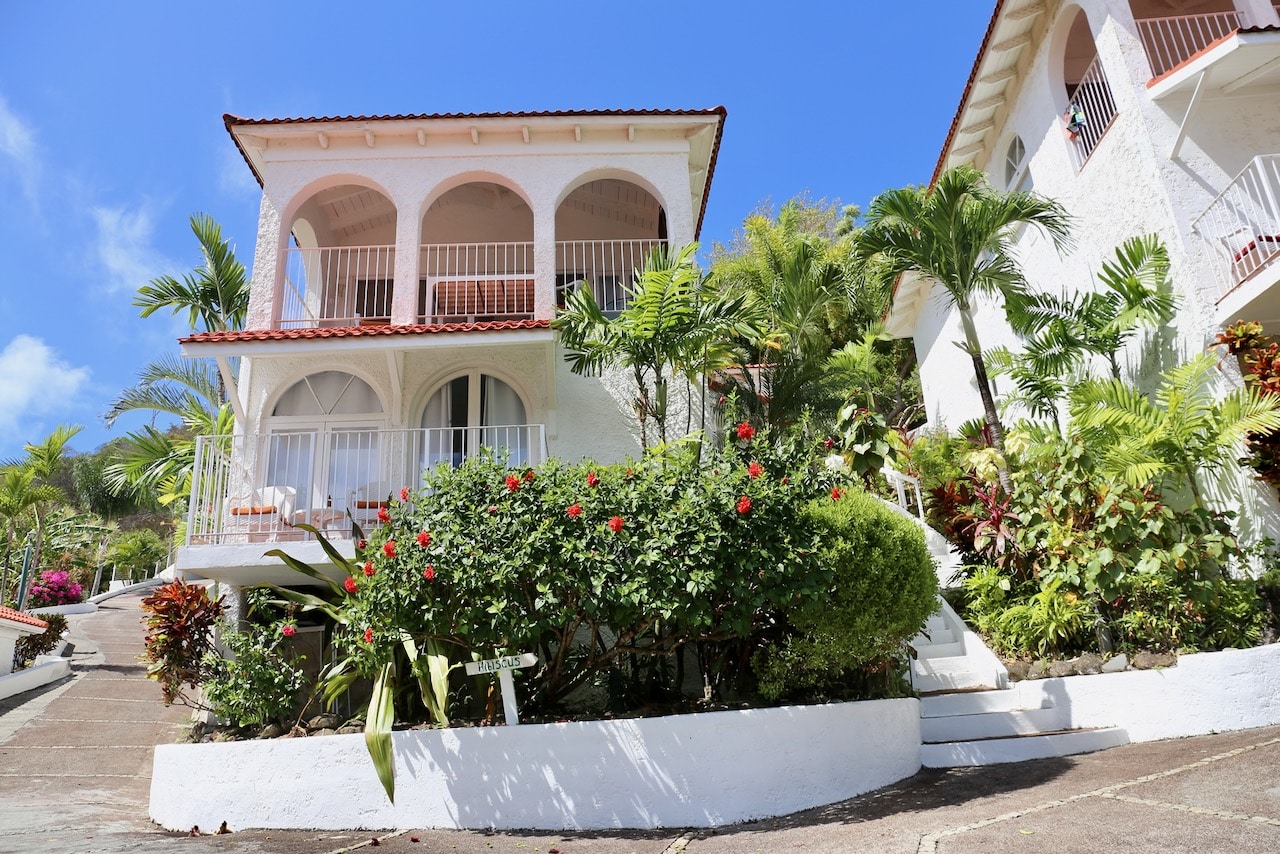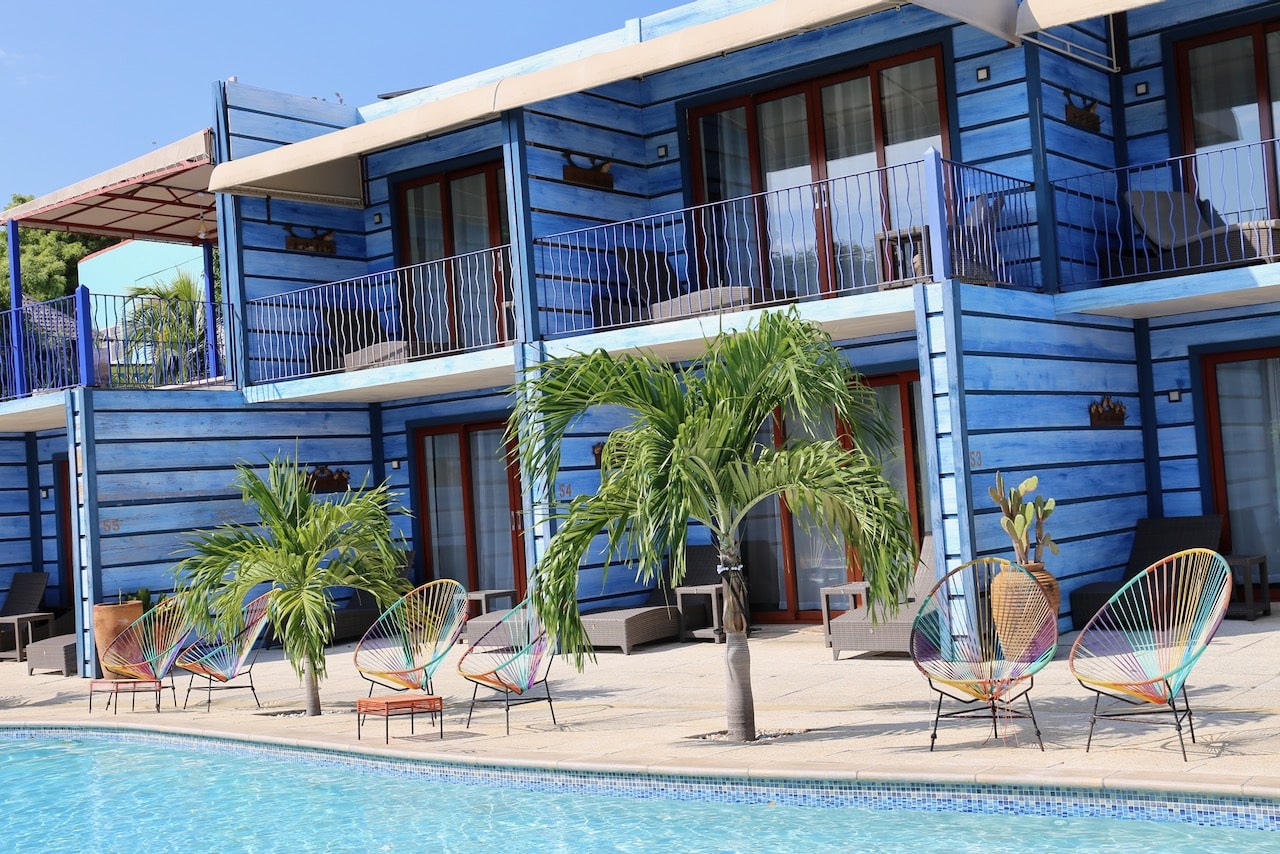It is not often that I find myself deliberately waking up at five in the morning. However, it is surprisingly easy to wake at this hour when your entire body is gitty with excitement. I bolted right out of my bunk, yanked on my shoes and headed out the door with Kat for Ikebekuro Station. At 6am we stood at the main entrance of Tsukiji Fish Market, the biggest wholesale fish and seafood market in the world. The markets proper name is, The Tokyo Metropolitan Central Wholesale Market (as there are several other buildings that sell spices, fungi and fresh produce).
The are two distinct sections of the Fish Market. The inner market (jonai shijo) is the licensed wholesale market, where the infamous tuna auctions and most of the processing of the fish take place, and where licensed wholesale dealers (approximately 900 of them) operate small stalls. The outer market (jogai shijo) is a mixture of wholesale and retail shops that sell Japanese kitchen tools, restaurant supplies, groceries and famous “fresh from the market” sashimi restaurants. The market handles more than 400 different types of seafood from tiny sardines to 300kg tuna, from cheap seaweed to the most expensive caviar. Overall, more than 700,000 metric tons of seafood are handled every year at the three seafood markets in Tokyo, with a total value in excess of 600 billion yen (approximately 5.5 billion US dollars). Tsukiji alone handles over 2000 metric tons of seafood per day. The number of registered employees at the market varies is 65,000, including wholesalers, accountants, auctioneers, company officials and distributors.
The market opens at 3am with the arrival of the products by ship, truck and plane from all over the world. Particularly impressive is the unloading of tons of frozen tuna. The auction houses then estimate the value and prepare the incoming products for the auctions. The buyers also inspect the fish to estimate which fish they would like to bid for and at which price. The auction starts at 5:20am on the dot and end around 7am. Afterwards, the purchased fish is shipped on small motorized carts and moved to the many tiny shops located inside the market. There the shop owners cut and prepare the products for retail. Frozen tuna are often cut with large band saws, and fresh tuna is carved with extremely long knives (some well over a meter in length).
If you want to visit the market as a tourist in Tokyo, you really need to do your research in advance, as you can see. We arrived at the perfect time and spent one hour snapping pictures like paparazzi. The early bird truly does get the worm. We noticed some people arriving at the market at 8:30am and felt compelled to tell them to go home. It’s sort of funny when you think about it, an 8:30am arrival is considered too late, when it comes to action packed fish markets.
I will forever remember my first impression of the market. We walked through the back end where bagged fish on ice were being loaded onto trucks for delivery within the city. All of a sudden we entered a large open area which made me feel as though we were standing in the middle of an express highway. Fish scooters whizzed along the road as a police officer tooted his whistle on a raised platform in an honest attempt to organize fish traffic. A collision of tuna meets octopus would not be a desirable situation, so they try there best to systematize the traffic flow. Each scooter driver wears a Tsukiji Fish Market t-shirt, a white towel around his forehead and stands in front of a massive steering wheel as they jostle across the pavement with crates full of seafood towering behind them.
Once across the insanely busy Fish Scooter Highway we entered the covered Fish Market building. Everything about the market is busy, neat and surprisingly odourless. We walked past a pile of discarded fish heads heaped on the ground and after finding a safe street corner I had a chance to look across the vast market space. The place must have been the size of several football fields. Row after row after row of perfectly organized spiked sea urchins, bright red octopus, giant squid, fuzzy lobster and thin silver sardines. I stood in horror as a fish monger with his bare hands grabbed a Flounder, hacked its head off and threw its lifeless body into a huge crate full of fish death. There were also several eel specialists who would tap a nail into a dead eels eyeball to fix its body just so, and then with a long knife slice the long snake like fish down the middle. The most horrifying experience was when Kat and I stood behind a rather sexy fish monger who grabbed a large flat green fish and with a serrated knife started to saw through its head. I can still hear the sound of bone meets blade and the flap flap of the petrified fish on the wet wooden cutting board. One can never be prepared for such gruesome business at this ungodly hour.
We had arrived after the tuna auctions. Perfect timing as the frozen fish cadavers had been distributed to each of the various market processing areas. The wet floor was covered in large frozen tuna carcasses. I stood carefully in between two severed tuna heads (which are approximately the size of a large pizza) and watched as skilled men used massive bladed machines to saw each fish into sections. Each of the sections was then manually de-boned with the utmost care. Throughout the market I noticed many piles of leftover Tuna remains. Heaps of bone sitting on the floor without a trace of flesh. Which makes sense, since tuna sashimi costs an astronomical amount over here. Once de-boned, master sushi artists work away cutting the flesh into various sized steaks. These hunks of raw tuna range in size from large to very thinly sliced tuna sashimi ready for consumption. After seeing several hundred thousand dollars of raw tuna I told Kat I thought tuna fish popsicles would be a very lucrative and innovative business venture.
The market proved to be a sensory overload experience. We both agreed a calm spot to enjoy breakfast would be to our betterment. Just a short stroll from the market we found a sidewalk teaming with noodle shops. I ordered my first piping hot bowl of udon noodle soup with a massive shrimp tempura propped on the lip of the bowl. The tempura was hot out of the oil and crispy against my teeth. The shrimp was the size of a newborn babies arm and crisp like a carrot. Kat and I went on and on about what we had just witnessed at the wildest fish market in the world while smiling over our steaming bowls of noodle soup.
We walked a few blocks towards the cities ritziest neighborhood, Ginza. The neighborhood is Japan’s Rodeo Drive and lined with up-market department stores, boutiques, restaurants and coffeehouses. This is the notorious district where you can buy a $40 dollar hamburger. The spot where Japan developed its “insanely expensive to eat here” urban legend. The heart of Ginza is the intersection of Chuo-dori and Harumi-dori, dominated by the glass cylinder of the San-ai Building. With its huge neon sign, it’s been the image of Ginza on postcards and travel books for decades. The other corners are occupied by Wako and Mitsukoshi, two of the most prestigious department stores and the Nissan Gallery which shows off new and classic automobiles. The tall and slender Sony Building contains, The Sony Showroom which contains four floors of the latest Sony products. The side streets of Ginza are full of art galleries featuring everything from paintings, photography and graphic design.
Kat and I first happened upon the neighborhood as we stood directly in front of the famed Kabukiza theater. The massive theater entertains locals and tourists alike with daily shows of traditional Kabuki performances. Kabuki Theater is known for the styilization of its drama and for the elaborate make-up worn by some of its performers. The word kabuki is believed to derive from the verb kabuku, meaning “to lean” or “to be out of the ordinary”, so kabuki can be interpreted to mean “avant-garde” or “bizarre” theater. In front of the theater entrance we stared at a massive poster of the various theater actors dressed up in their costumes. A wild bunch!
We walked through the streets of Ginza before any of the stores were open. The streets were quiet and perfect for a pair of amateur photographers. At a red light we laughed hysterically as a Japanese man driving a Mercedes rolled down his window. He was wearing a huge cow boy hat and smiled at us with his fingers in the expected peace sign position. Only in Japan will someone roll down their window and ask foreigners to take a picture of them. Ginza’s famed Apple Store which was the first Apple store to open outside of The States stands like a massive glass cube on the corner of one of the main streets. We walked along the street past architectural buildings which forced us to stop and marvel at them. Each housed a different haute couture fashion house; Hermes, Chanel, Prada, Gucci, Louis Vuitton and Armani. After walking down a rather decadent street we arrived at the beautiful Yurakucho Center Building at Sukiyabashi intersection where Kat waved goodbye and I continued with my own solo itinerary.
I continued across the street and within minutes I was walking through Hibiya Park which is spotted with lily ponds and sculpture filled gardens. On the other side of Hibiya a stone bridge straddles the Imperial Moat. Inside the Imperial Palace Gardens hundreds of oddly shaped trees stand on a grassy grid, perfectly equal-distance apart from each other. In the hot midday sun several homeless men lay curled under these Dr. Zeus tree branches. The Palace is not open to the public but tourists flock to the entrance in order to take pictures of the famed Nijubashi entrance. A beautiful Edo decorated stone bridge stands over the river and a cute little Shogun castle sits above it flanked by soaring trees.
I hopped on the train and headed for The National Art Center Tokyo, smack dab in the middle of the city. The architect for the museum was Kisho Kurokawa and the facility has 47,960 square meters of floor space on a 30,000 meters squared site with four stories above ground and one below. The National Art Center is a unique and innovative art exhibition facility: instead of maintaining a permanent collection, it makes the most of 14,000 square meters of exhibit space, the largest in Japan, and focuses on serving as a venue for various art exhibitions from around the world. The building is a masterpiece in contemporary architectural design. The exterior is made entirely of glass which rolls like a wave of organic movement. The interior of the Center features a long central hall with a beautiful Café on the first two floors. The building is absolutely huge. With six exhibition rooms, it really seems like six art galleries held together by a central boulevard, Café and Museum Shop.
The big exhibit playing at the moment was Modigliani et le Primitivisme. I bought my ticket and spent the next hour listening to Sigur Ros’s, Hvarf Heim album while walking through what seemed like a never ending maze of art covered walls. The Japanese are notorious for their love of art. They turn out in droves. Year after year, the nation wins the, “most visited art galleries” award by a landslide. A few years ago a Picasso exhibit showed in Tokyo and it was recorded that over half a million people visited a day. The Modigliani exhibit was no different. I stood in a long line which sort of made me want to break out and do the Conga. The line snaked across the entire exhibit space as people slowly stared up at the various pieces.
Amedeo Modigliani was born in Italy, in the region of Tuscany, studied at art schools in Florence and Venice before leaving for Paris in 1906. His encounters with Primitivism, which incorporated aspects of African and Oceanic folk art, gradually led Modigliani to a simplified, trenchant sense of form. The simple, pure forms of primitive art had also been important sources of direction for Picasso, Matisse, and other members of the School of Paris in their quests for their own individual styles. This exhibit, which includes 150 works by Mondigliani being shown in Japan for the first time, is a major event on an international scale, especially given that Modigliani’s entire output in oils is said to total only about 400 paintings.
I think I may have enjoyed the Art Center’s Museum Shop located on the bottom floor even more than the actual exhibit! By far the best Art Gallery Shop I have ever encountered. The enormous space sold hundreds of art covered postcards, Japanese hand made cloth dolls, a fashion corner selling bags, dresses and hats, Art bookcases, photography tributes, and a central design area which sold everything from wacky chairs to Japanese robot dogs.
The National Art Center Tokyo is located on the Art Triangle Roppongi. The three Art Galleries located on this triangle are The Art Center Tokyo, Suntory Museum of Art and The Mori Art Museum. I walked towards the Suntory Museum of Art which is located in Tokyo Midtown.
The Midtown is a 569,000 square meter mixed use development in Minato, central Tokyo. Completed in March 2007, the $3 billion project includes office, residential, commercial, hotel and leisure space as well as the tallest building in Tokyo. The mixed use development concept is the new “it” concept in Japan and my favorite part of Tokyo’s quirky culture. Major tenants of Midtown are Fujifilm, Xerox, Yahoo! Japan, Ritz Carlton Hotel and a medical clinic affiliated with the U.S. based Johns Hopkins Hospital. The 5th floor retail Galleria, with 786, 000 square feet of designer clothing stores, world famous restaurants and shops includes the first Terence Conran restaurants in Japan, a wine bar (Coppola’s Vinoteca) showcasing the wines of Francis Ford Coppola, and an outlet of high end American food retailer Dean & DeLuca. The Midtown is also the home of Design Sight 21_21, a design gallery/workshop created by fashion designer Issey Miyake and architect Tadao Ando.
I keeled over after arriving in Midtown as I would never have thought that the ingenious builders of Tokyo could have outdone the Roppongi Hills concept! I’ve learned to never be surprised by what I encounter here. The entrance of the Tokyo Midtown complex really does require the viewer to sit down and just stare. An investigation with the eyes. A massive stone organic doughnut sculpture sits beside the sidewalk. An odd looking water fountain which doubles as a waterfalls runs through the center of the space. The ground is made up of a mix and match of polished stone and wooden planks. On either side of the fountain stand patches of bamboo grove which sway in the wind like long strands of grass. My favorite part of this modern Japanese park were the contemporary benches made of mahogany wood that slope down on an incline like that of a skateboard ramp. I lay across one of these benches entirely comfortable and content while staring up into the sky at the cities tallest buildings. I was reminded that nature still does exist in the core of the metropolitan as the smell of perfumed flowers hit my nose and bamboo twisted and turned in the sky above.
I spent the next hour walking through the fabulous Ritz Carleton lobby, Galleria high end window shopping and stared into some of the most beautiful restaurant spaces that I have ever encountered. Each of the restaurant fronts have a large pane of glass which you can peak through to see the chefs from each restaurant preparing their daily gourmet creations. I stood over a banister looking through a three story window which overlooked the backyard of the Midtown complex.
A beautiful park full of gardens and massive sculptures. One particular sculpture looked like a totem pole of mercury or water droplets frozen in time as they cork screwed into the air. I was enamored with this metallic pole of wobbly organic reflections. Depending on which direction you stand looking at the totem you can make out various hidden silhouettes in the sculpture. Looking from the south I could see a woman’s face and walking to the other side I was able to make out a dogs snout. I walked back into the Galleria building through the bottom floor which featured several “only in Tokyo” moments. I stopped in front of a massive store with a sign that read: “holistic pet products, grooming, dog spa, dog hotel, dog hospital.” I was also rather shocked by a very high end Fruit Boutique which sold outrageously expensive fruits which sit propped in designer display fridges, dressed in gift wrap like little dolls. As I wondered along the main hall I took in the smells from ritzy chocolate shops, French bakeries, espresso shops and a boutique which specialized in obscenely priced sauce filled jars.
I hopped on the subway and for the first time felt a bit awkward. The entire train car was full of woman and they stared at me disapprovingly. One middle school girl pointed to the window where a large pink sticker read: “Women Only: when located at the rear end of the train this car is for Women Only on weekdays for all trains.” These special cars were apparently introduced to combat illegal obscene conducts including groping. Groping in crowded commuter trains ahs been a problem in Japan; according to a survey conducted by Tokyo Metro Police, two thirds of female riders in their twenties and thirties reported that they have been groped on trains, and the majority had been victimized frequently. So, I quickly got off at the next station and rushed to the next car which was male gender friendly!
I got off at Shibuya station which features the Time Square of Tokyo. The station is known for its famous Hachiko, brass statue of a cute little dog which most locals use as a meeting point. Hachiko waited on his late master at Shibuya Station every day from 1923 to 1935, eventually becoming a national celebrity for his loyalty.
Shibuya is a major nightlife area in Japan and a fashion district for young people. Harajuku is actually located just north of the station so many consider Shibuya Station the gateway to modern Japanese street fashion. Shibuya is famous for its scramble crossing which is The Worlds Busiest Intersection. It is located in front of the Station and stops vehicles in all directions to allow pedestrians to inundate the entire intersection. Three large TV screens mounted on nearby buildings overlook the crossing. The Starbucks store overlooking the crossing is also the busiest in the world. The 2003 movie Lost in Translation featured a scene. Scarlette crosses the busy street and stares up in awe at a huge brontosaurus walking across the massive screens affixed to the towering buildings above.
I jumped up onto a bench which faced the intersection and spent the next ten minutes laughing myself silly whenever the green walk light lit up. Imagine a mass of thousands of people walking across five street corners. It is the only street corner in the world where I have seen people cross on a diagonal. Surely a time saver! You really need to know where you are going here. I took some amazing pictures a few seconds after people stared to cross the intersection. It is at this point when it looks like an ocean of Japanese people are standing in the middle of a road.
I had about two hours to doddle before I met Kat for our dinner date reservation. I walked to Shibuya Center Gai Department store and had an awkward ten minutes with a local photographer. This tall Japanese guy comes up to me with a massive professional camera around his neck which looked sort of like an outrageously large necklace. Far more practical than a diamond I might add, probably just as expensive, and arguably just as beautiful. He handed me his card and told me that he was a photographer from Tokyo (what a shock) and that he takes pictures for a contemporary Japanese street fashion magazine. I agreed to let him take pictures of “my style” and was soon inundated by his papparazzi. What I thought would be maybe a 30 second commitment became a 10 minute awkward street side photo shoot. He even had the gall to tell me where to stand, how to place my arms and where to look. People started to gather and stare. He crouched down on his haunches, stuck the camera directly under my nose and even told me to sit on the wet ground to “interact with the environment.” Good grief.
The Department store was a great place to get out of the rain. I walked through three floors of men’s designer clothing. I was desperate to purchase the Japanese leather pointy studded boot which is very in right now. Unfortunately these clock in at around $1200 each. I’ll have to learn how to make my own it seems.
With another hour to putter I decided to indulge in my much loved people watching hobby. Shibuya is a remarkable spot to just sit and stare at the people that go by. I sat at a McDonald’s on the third floor of a building which overlooked a busy intersection. I munched on a hamburger, chocolate croissant and a ShakaShaka Chicken filet. Unfortunately I sat beside a homeless lunatic woman smoking a thin cigarette, who manically muttered under her breath in Japanese as she ate a big mac. You could grow a daisy out of her thumb with the soil residing under her finger nails.
My next stop was Segafredo Zanetti Italian Espresso Bar where I ordered a double espresso, pear pistachio brioche tart and almond biscotti. I found a comfy chair on the third floor of the building and dabbed my forehead with a napkin as it was sopping wet. I sat journaling while my eyes pulsed with caffeine. Perhaps the reader has forgotten that I have been up since 5am at this point. I had seen an incredible amount of the city today and I was a few hours yet from a hostel shower and rest.
I stood outside of The Lockup for Kat. We hugged with big smiles smacked across our faces as we headed downstairs for the entrance. The Lockup is a famous Tokyo based theme restaurant (there are three in the city). It takes a few minutes to get from the main entrance of the restaurant to the hostess table as each patron must walk through a dark haunted house to get to their table. I thought the haunted house was a nice touch. Screaming men in electric chairs, glowing aliens and dungeon rooms. Once we pushed through the main door a beautiful woman dressed as a scantily clad Prison Warden took our reservation name. She took my hand and snapped a single handcuff to my left arm which was attached to a long chain. She then walked me through the dimly lit bar to our seats. We took off our shoes and crawled into our small prison cell. A wire gate was snapped shut and we were locked in. As we chatted over our menus we could hear other patrons coming through the haunted house as they screamed in fright. Throughout the evening I could hear the click clack of the Hostess/Wardens high heels and following her long chain I could see the terrified and giggling dinner party following behind her. I often screamed or moaned from our cell to terrify them a bit more. I love an interactive feast!
The menu follows along with this haunted house prison theme. The drinks menu is full of odd little creations. You can order shots in test tubes, beakers are served with a red syringe propped along the brim so you can squeeze your liquor into the juice which glistens in the bottom of the glass.
We ordered a beaker which featured a gelatinous human eyeball. We were given a bowl of breadsticks to dip in sweet whipped cream cheese. Our waitress knocked on our jail cell door and pulled back the screen. She was dressed in a black and white striped chain gang outfit. We spent the next hour munching on a plate of Omurice filled with pork, bean, sweet mango, and green onion. Our second dish was called Russian Roulette which featured five bowls of cold soba noodles. Four of the bowls featured a sweet soya sauce but one of the bowls was lathered in a mysterious wasabi spicy sauce. We slowly nibbled at each bowl, certain not to down an entire bowl in fear that it may burn our mouths.
After our rather nostalgic dinner we walked to Shibuya Station. I once more crossed the massive, crazy and overwhelming intersection but this time around it was pitch black and the overhead mega screens glowed in the dark of night. The craziness of Tokyo has a odd sense of romanticism to it. It’s sort of Paris on crack.
We arrived back at Ikebukuro Station just after 8pm. We stopped at a convenience store on the way to our hostel, where I bought a Hagen Daz strawberry ice cream sandwich and two cans of grapefruit vodka cocktail. I had officially been on my feet for 15 hours, non-stop. I enjoyed a warm shower and sat in the hostel common area as the vodka cleared my mind. I slid into “bed” and instantly fell to sleep, excited for what my last day in Tokyo would have in store for me.


